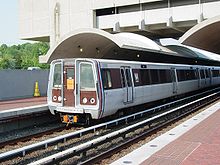This is an old revision of this page, as edited by Ground Zero (talk | contribs) at 23:26, 18 November 2016 (The foundation of something is its origin. Avoid redundancy.). The present address (URL) is a permanent link to this revision, which may differ significantly from the current revision.
Revision as of 23:26, 18 November 2016 by Ground Zero (talk | contribs) (The foundation of something is its origin. Avoid redundancy.)(diff) ← Previous revision | Latest revision (diff) | Newer revision → (diff)| This article needs additional citations for verification. Please help improve this article by adding citations to reliable sources. Unsourced material may be challenged and removed. Find sources: "Rohr, Inc." – news · newspapers · books · scholar · JSTOR (July 2015) (Learn how and when to remove this message) |
Goodrich Aerostructures Group, formerly Rohr, Inc., is an aerospace manufacturing company based in Chula Vista, California, south of San Diego. It is a wholly owned unit of the Goodrich Corporation and was founded as Rohr Industries.
Rohr's main product line are aerostructures, such as engine-related components, including engine nacelles, thrust reversers, and mounting pylons for military and commercial aircraft. It also consults on integrating and managing its designs with the aircraft's other systems.
Other products include auxiliary power units, flight control surfaces, and other aircraft parts.
History

Frederick H. "Pappy" Rohr (Fred), creator of the fuel tanks for Charles Lindbergh's Spirit of St. Louis, founded Rohr Aircraft Corporation on August 6, 1940 with the help of Reuben H. Fleet after approaching him for a job. The company incorporated as Rohr Corporation in 1969, and changed its name to Rohr Industries, Inc. in 1971.
In the 1960s and 70s, Rohr Industries made a foray into mass transit equipment manufacturing. It manufactured railcars for Bay Area Rapid Transit (BART) in the San Francisco Bay Area, and the first 300 subway cars for the Washington Metro in Washington, D.C. among others (see Washington Metro rolling stock). In 1970 it produced an experimental aérotrain design, the TACV, and purchased the rights to the Monocab design and turned it into the ROMAG. In the same year it acquired the Flxible Company, a bus manufacturer, which would produce a Transbus design, which evolved into the Model 870 Advanced Design Bus, as well as the later Flxible Metro, which addressed all of the shortcomings of the Model 870. Rohr divested itself of, or discontinued those programs by the late 1970s.
Rohr Industries became Rohr, Inc. in 1992. It was listed on the New York Stock Exchange under the ticker symbol RHR, until it was acquired by the Goodrich Corporation in 1997 and remained separately incorporated company as Goodrich Aerostructures. In August 2012, United Technologies Corporation (UTC) purchased Goodrich Corporation and all its divisions. After the acquisition, UTC created an aerospace systems division (United Technologies Aerospace Systems - UTAS) which all divisions of Goodrich Aerostructures and UTC's Hamilton Sundstrand divisions were incorporated into one entity.
Sales and divestitures
UTC sold its UTC Power unit in early 2013 to Oregon-based ClearEdge Power. UTC sold the former Goodrich electric power systems to SAFRAN for $400 million. This was a divestiture that was a condition of UTC's 2012 acquisition of Goodrich. Pratt & Whitney's Rocketdyne operations were sold to jet engine maker GenCorp for $550 million in mid-2013. Three former Hamilton Sundstrand businesses, Milton Roy, Sullair, and Sundyne, were sold to private equity firms BC Partners and The Carlyle Group for $3.46 billion.
References
- "Frederick H. "Pappy" Rohr". July 7, 2014. Retrieved July 2, 2015.
- "About ROHR, INC". company profile. Vault. 2015. Retrieved July 2, 2015.
General references
External links
- Goodrich Aerostructures Group official site